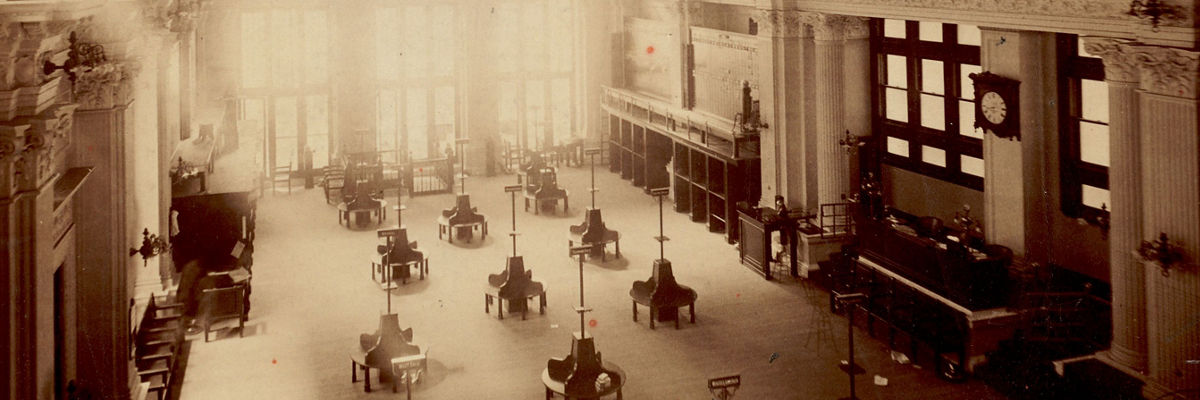
Democracy for All: L. Sherman Adams
From the beginning of his tenure as a trustee in 1924, Sherman Adams consistently advocated on behalf of everyday investors, from an unprecedented redemption feature to promoting open dialogue and debate among the trustees.
One of the early trustees of Massachusetts Investors Trust (MIT), L. Sherman Adams had a profound and lasting influence on the growth of the firm and the development of the collaborative culture and client-aligned mindset MFS® is known for today. The tenacity of Adams’ commitment to everyday investors shaped MIT into the most democratically minded investment vehicle the world had ever seen.1
Adams joined MFS in the summer of 1924, shortly after MIT’s incorporation,2 which had legally established the creation of the firm. At a time when the investment industry routinely ignored everyday Americans’ fears of investing and the markets, Adams recognized how MIT could not only address their fears but provide small investors access to the markets so they could build long-term wealth through the stock market. By combining professional active management, diversified holdings and a revolutionary redemption feature, which allowed investors to sell back their shares to the fund’s sponsors at any time with no strings attached,3,4 MIT would give shareholders a single dynamic product that offered a level of market access and liquidity wholly unavailable to them at the time.5
Adams worked diligently with his fellow trustees, insisting they refine and preserve MIT’s redemption feature.6 They officially offered the redemption feature to investors on September 25, 1924,7 shaking the investing world to its core by allowing investors to easily buy and sell the fund as they saw fit.8 Without Adams’ guidance and the persistence of his belief in the good it could do, this groundbreaking redemption feature was unlikely to have survived.

By combining professional active management, diversified holdings and a revolutionary redemption feature, which allowed investors to sell back their shares to the fund’s sponsors at any time with no strings attached, MIT would give shareholders a single dynamic product that offered a level of market access and liquidity wholly unavailable to them at the time.

As he continued to focus on what would best serve everyday investors, Adams played a critical role in fine-tuning the firm’s holdings, assembling a diversified portfolio of stocks that represented “a composite investment in American industry.”9,10 Knowing that transparency was also essential for earning the trust of shareholders, Adams championed the radical idea that MIT should publish transparent investment reports that revealed the fund’s holdings and other details about the firm’s operations, information which virtually no other manager was willing to share with investors.11
Adams and the other trustees prioritized diversification, liquidity, conservative portfolio management and transparency, which proved critical in helping MFS weather the Great Crash of 1929 and the ensuing Great Depression.12 While the general public’s faith in the markets plunged during the 1930s, its faith in MFS grew with each passing year, as the firm was one of the few safe havens helping investors regain their financial footing during an economic crisis.13
By the time Adams retired in 1952,14 MIT had solidified its standing as the largest open-end mutual fund in the world — largely driven by Adams’ experience, passion and his dedication to the financial success of everyday people. As CNBC anchor and market scholar Bill Griffeth wrote in his book The Mutual Fund Masters, Adams’ influence on the development of MIT made him “arguably the father of the modern mutual fund.”15
Please note: Not all of the funds included in this material may be available for sale in your country.
Endnotes
2 Wilson, J. (1949) A Story of Progress: On the Twenty-Fifth Anniversary of Massachusetts Investors Trust. Massachusetts Investors Trust.
3 Robinson, D. (1954). Massachusetts Investors Trust: Pioneer in Open-End Investment Trusts. The Newcomen Society in North America. Page 12.
4 MFS Turns 75. (1999) MFS Perspective. Vol 5, No. 1.7. Page 14; Wilson, page 10; Silberman, page 2.
5 Rottersman, M. & Zweig, J. (1994). An Early History of Mutual Funds. Friends of Financial History. Museum of American Financial History. Vol. 51. Page 15.
6 Griffeth, B. (1995). The Mutual Fund Masters. Probus Publishing; and Silberman, page 3.
7 Silberman, page 10.
8 Hall, B. & Lim, J. (2004). Massachusetts Financial Services. Harvard Business School Case Study 9-902-132.
9 Griffeth, pages 1–2.
10 Wilson, page 16.
11 Wilson, pages 15–16.
12 Willis, C. (February 1999). Present at the Creation. MF Magazine.
13 WALL STREET: The Prudent Man. (1959) Time Magazine. http://content.time.com/time/subscriber/article/0,33009,811169-1,00.html
14 Grow, page 58.
15 Griffeth, page 11.